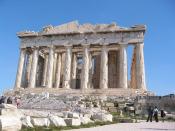Ancient Rome
Economic Patterns:
Ancient Rome was an agrarian and slave based economy whose main concern was feeding the vast number of citizens and legionaries who populated the Mediterranean region. Agriculture and trade dominated Roman economic fortunes, only supplemented by small scale industrial production. The staple crops of Roman farmers in Italy were various grains, olives, and grapes. Olive oil and wine, outside of direct food stuffs, were among the most important products in the ancient civilized world and led Italy's exports. The production and transportation of foods dominated the trading industry but there was also a vast exchange of other goods from all parts of Europe, Asia, and Africa. The prosperity of the Empire and many of it citizens generated a need for luxurious and exotic imports. Silks from China and the Far East, cotton and spices from India, Ivory and wild animals from Africa. Extensive Trade routes were established on land and sea.
While a benefit of a large network of roads was the transport of goods, their most significant purpose was the fast mobilization of the Legions. Most large-volume, cumbersome goods, such as food, precious metals, stones and building supplies, were shipped by water. Numerous sea lanes provided cheap and easy access to all parts of the Mediterranean.
The largest industry in ancient Rome was mining, which provided the stones for the enormous building projects and metals for tools and the weapons that conquered the western world. Marble was provided from Northern Italy and Greece for the buildings that awed the ancients and modern people alike. Large quantities of gold and silver were mined in Spain to mint coins and create jewelry, while mines in Britain produced iron, lead and tin for weapons. Cities and towns throughout the empire established small-scale manufacturing plants which turned out hand-made...



Ancient Rome
This essay is very well written and has several points of interet covered within its body. The research done was obviously extensive and it shows great preperation.
1 out of 1 people found this comment useful.